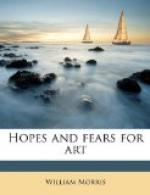Every one who has practised the designing of patterns knows the necessity for covering the ground equably and richly. This is really to a great extent the secret of obtaining the look of satisfying mystery aforesaid, and it is the very test of capacity in a designer.
Finally, no amount of delicacy is too great in drawing the curves of a pattern, no amount of care in getting the leading lines right from the first, can be thrown away, for beauty of detail cannot afterwards cure any shortcoming in this. Remember that a pattern is either right or wrong. It cannot be forgiven for blundering, as a picture may be which has otherwise great qualities in it. It is with a pattern as with a fortress, it is no stronger than its weakest point. A failure for ever recurring torments the eye too much to allow the mind to take any pleasure in suggestion and intention.
As to the second moral quality of design, meaning, I include in that the invention and imagination which forms the soul of this art, as of all others, and which, when submitted to the bonds of order, has a body and a visible existence.
Now you may well think that there is less to be said of this than the other quality; for form may be taught, but the spirit that breathes through it cannot be. So I will content myself with saying this on these qualities, that though a designer may put all manner of strangeness and surprise into his patterns, he must not do so at the expense of beauty. You will never find a case in this kind of work where ugliness and violence are not the result of barrenness, and not of fertility of invention. The fertile man, he of resource, has not to worry himself about invention. He need but think of beauty and simplicity of expression; his work will grow on and on, one thing leading to another, as it fares with a beautiful tree. Whereas the laborious paste-and-scissors man goes hunting up and down for oddities, sticks one in here and another there, and tries to connect them with commonplace; and when it is all done, the oddities are not more inventive than the commonplace, nor the commonplace more graceful than the oddities.
No pattern should be without some sort of meaning. True it is that that meaning may have come down to us traditionally, and not be our own invention, yet we must at heart understand it, or we can neither receive it, nor hand it down to our successors. It is no longer tradition if it is servilely copied, without change, the token of life. You may be sure that the softest and loveliest of patterns will weary the steadiest admirers of their school as soon as they see that there is no hope of growth in them. For you know all art is compact of effort, of failure and of hope, and we cannot but think that somewhere perfection lies ahead, as we look anxiously for the better thing that is to come from the good.




